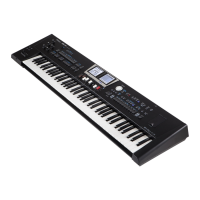Menu options
132
The other parameters in the page depend on the Mfx type that you
selected.
Mfx(1) Controls
1.
If you want to assign a control to a Mfx(1), you have to
push the dial to select the “Mfx Controls” page.
Right Display
2. Select and set the desired parameter(s). See “Browsing
Windows and Setting Parameter Values” (p. 26).
Parameter Setting
Control1 Source MFX1 Ctrl, MFX2 Ctrl
Control1 Sens -63~+63
Control1 Assign
The eects to assign depend on the Mfx type that you
selected
Control2 Source As Control1 Source
Control4 Assign As Control1 Assign
Mfx2
For the Mfx2 parameters refer to Mfx1.
Reverb
Parameter Setting Explanation
Reverb Switch O, On
Select “O” you don’t need any reverb
eect.
Reverb Type
1: SRV Room,
2: SRV Hall,
3: SRV Plate,
4: GM2 Reverb,
5: Room1,
6: Room2,
7: Stage1,
8: Stage2,
9: Hall1,
10: Hall2,
11: Delay,
12: Pan Delay
This parameter allows you to select one
of the twelve eects types, two of which
are actually delay eects.
Reverb Edit
The parameters to assign depend on
the Reverb Type that you selected. See
below.
Reverb Edit “1: SRV Room”, “2: SRV Hall”, “3: SRV Plate Types
Parameter Setting Explanation
Level 0~127 Output level of the reverb signal.
Reverb Edit “1: SRV Room”, “2: SRV Hall”, “3: SRV Plate Types
Parameter Setting Explanation
Pre Delay 0.0~100.0 ms
Adjusts the delay time between the
direct sound until the reverb sound
is heard. This is used to simulate the
distance between the original signal and
the reective surfaces.
Time 0~127
The duration of the reverb signal.
The higher the value, the “longer” the
simulated room becomes.
Size 1~8
Determines how the later reverberations
are propagated, which gives the listener
important clues about the height of the
simulated room.
High Cut
160~12500Hz,
Bypass
Adjusts the frequency above which the
highfrequency content of the reverb
will be reduced. If you do not want to
attenuate the high frequencies, set this
parameter to BYPASS.
Density 0~127 Density (number) of the reections.
Diusion 0~127
Adjusts the change in density of the
reverb over time. The higher the value,
the more the density increases with
time. (The eect of this parameter is
most noticeable with long reverb times.)
LF Damp Freq 50~4000Hz
Adjusts the frequency below which the
lowfrequency content of the reverb
sound will be reduced.
LF Damp Gain –36~0dB
Adjusts the amount of damping applied
to the frequency range selected with “LF
Damp”. With a setting of “0”, there
will be no reduction of the reverb’s
low-frequency content.
HF Damp Freq
4000~
12500Hz
Adjusts the frequency above which the
highfrequency content of the reverb
sound will be reduced.
HF Damp Gain -36~0dB
Adjusts the amount of damping applied
to the frequency range selected with “HF
Damp”. With a setting of “0”, there will be
no reduction of the reverb’s high-
frequency content.
Reverb Edit ”4. GM2Reverb” Type
Parameter Setting Explanation
Level 0~127 Output level of the reverb signal.
Character
Room1,
Room2,
Room3, Hall1,
Hall2, Plate,
Delay, Pan
Delay
Type of reverb
Pre LPF 0~7
Cuts the high frequency range of
the sound coming into the reverb.
Higher values will cut more of the high
frequencies.
Level 0~127 Output level of the reverb signal.
Time 0~127 Time length of reverberation.
Feedback 0~127
Adjusts the level of the delay sound
that is fed back into the eect when the
“Character” setting is “Delay” or “Pan
Delay”.
Reverb Edit “5. Room1” ~ “12. Pan Delay” Types
Parameter Setting Explanation
Level 0~127 Output level of the reverb signal.
Time 0~127 Time length of reverberation
HF Damp
200~8000Hz,
Bypass
Adjusts the frequency above which the
highfrequency content of the reverb
sound will be cut. If you do not want
to cut the high frequencies, set this
parameter to BYPASS.

